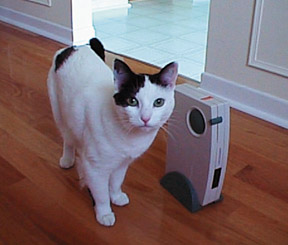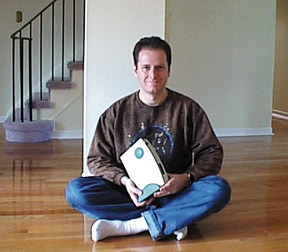Product Review: Corel's NetWinder
Manufacturer: Corel Computer
URL: http//www.corelcomputer.com/
Price: Varies with model, see web site
Reviewer: Marcel Gagné
Corel's NetWinder has to be one of the coolest computers I've ever seen. The slick little grey box makes me think of those cream-filled half-moon cakes with a little chunk taken off the edges. Sitting in its green plastic base, it beckons with a single deep red window up front and two status lights telling you everything is fine. It is about the size of my notebook, but unlike my notebook, it weighs next to nothing.
My time with the NetWinder was up a few days ago, but I have been hanging on to it due to problems in scheduling a drop-off time with the Corel sales representative. On my first attempt to deliver the unit, I stopped off at a customer's site, NetWinder in hand. It took an hour before I was allowed to leave again, as everybody in the office had to get a look. “That's a computer?” was heard time and again, as was “And it has what inside?” and “Tell me again what it can do?” If nothing else, the NetWinder gets looks. Luckily, there's more here than just looks.

Figure 1. The NetWinder fits into any decor!
The NetWinder is based on a 275MHz StrongARM SA-110 RISC processor which delivers 250 MIPS. It comes with 32 or 64MB of RAM and a 2, 4 or 6GB disk. There are two Ethernet interfaces, one 10 and one 10/100 fast Ethernet port. It draws 15 watts from its power brick, about the equivalent of a couple of night lights. The NetWinder WS also comes loaded with Perl for CGI scripting, the Apache web server, FTP, TELNET and DNS services. Also included are multimedia support, a 16-bit stereo sound card and 2MB SVGA/XVGA video.
The unit I reviewed is actually a DM demo. That translates to “a little bit of WS, DM, GS and LC all rolled into one”. Its OS version is based on Red Hat 4.2 with some Corel extensions. By the time you read this review, NetWinder will come preloaded with Red Hat 5.1.
A few different configurations are available. At this moment, there are five NetWinder configurations. The WS (Web Server) and the DM (Development Machine) are currently shipping. The LC (Linux Computer) should be out by the time you read this; I was told “in time for Christmas 1998”. The other two models, the RM (Rack Mount) and GS (Group Server), are expected in early 1999. Pricing and configuration options are available from the Corel Computer web site at https://www.corelcomputer.com/. The open source software and updates are available at https://www.netwinder.org/.
The WS is designed to be an “out of the box” web server. Small ISPs and corporate intranets or web sites are the most likely candidates for the WS.
The DM is aimed at the software designer and comes with a suite of development and programming tools. It is primarily for Corel NetWinder project developers.
The LC is seen as a business or enterprise desktop client, although I also see this as potentially quite attractive to the home user looking for a robust alternative to running MS Windows. It comes with X, the KDE windows environment, Netscape Communicator and WordPerfect 8. Supporting many client/server models, the LC comes with Sun's Java VM, a Citrix ICA client to access 32-bit MS Windows applications and good old terminal access.
For the workgroup environment, Corel offers the GS. Designed as a local enterprise server, the GS offers e-mail services, HTML authoring, discussion groups, and document management and indexing functionality.
Finally, there's the RM. This NetWinder will appeal to larger ISPs. Each RM can accommodate two NetWinders in the space of a single rack unit. That means a possible 80 NetWinders in a standard rack. Each RM is designed to be hot swappable from its partner. One from each pair can be removed without powering down the other unit.
I decided to review this unit while leaning toward the WS model, a more likely choice for ISPs and corporate intranets. When I got my NetWinder home, I plugged the unit in, hooked up the included mouse and keyboard and plugged in a 15-inch Digital SVGA monitor. The NetWinder does not come with a monitor, because in the case of the WS, Corel imagines the unit running in the background without being looked at. After all, it is designed to be a server and can be administered through a web interface. Personally, I can imagine lots of people wanting one of these on their desktops.
After a few seconds, I heard little start-up tones, “Too-loo-toong!”, followed by a strange, childlike voice saying, “Welcome to NetWinder”. (I later found out that this is one of the developer's children. The voice is kind of cute.) Next, I logged in, as per the tiny (not much more than a dozen pages) user's manual that came with it, as I was anxious to get started. I completely ignored the part about “setting it up for your network”.
I typed startx and was greeted by a bright, beautiful KDE desktop with Corel's logo floating on a black background. I flipped through the four virtual desktops, each with a different background. Number three, with its stone wall image as the background, nearly blew me away; the brilliant definition begged me to reach out and touch it in order to convince myself it wasn't real. Corel has put nice video into their NetWinders. This was actually the first time I had seen the KDE desktop, and I was so impressed with it that I now run it on my Dell XPi notebook. KDE is not included on the WS, but I couldn't resist playing with all the toys on my DM.
I wandered around the desktop, played a couple of hands of poker, and finally dragged myself back to writing this review. To set the machine up for my network, I plugged the 10Mbps port into a free port on the hub, typed netconfig and modified the address to fit in to my 192.168 existing class C. Then, I used Netscape to access the NetWinder from my Dell notebook running Red Hat 5.2.

Figure 2. So simple, even Natika can use it.
Right away, I was presented with WebFront, Corel's administrative interface for the WS. It took me awhile to figure out how to log in to the administration utility. After chasing through some of the CGI scripts under the /admin directory, I found a reference to /usr/bin/htpasswd.sh which apparently you must run at least once in order to get WebFront to realize your admin user is legit. This script creates the .htpasswd file.
WebFront is a browser-based tool that makes it possible to administer your NetWinder through a few simple forms. You can add, delete or modify users and groups through the interface. The clean, simple interface also serves up statistics on your NetWinder's performance in a graphical form, giving you glimpses of your web site's activity over different time scales.
To get a feel for its performance, I uploaded a few web sites that were done in Microsoft FrontPage. The transfer was very fast, a testament to the NetWinder's zippy little combination of processor and network architecture. I did a couple of these, one for our SF magazine TransVersions and another for a customer's intranet. Both sailed by faster than the “time to go” in FrontPage could keep up. What it estimated would take three plus minutes flew past in less than ten seconds.
Access to the pages was very fast. I fired up Netscape and as fast as I could click links, pages appeared in my browser. It was almost disconcerting. My local Pentium-powered Linux system, which we use as our corporate gateway/e-mail server/development machine, seemed to crawl in comparison. I was starting to get a touch of server envy.
Corel benchmarks with 16 clients connected to the NetWinder at 70 requests per second or nearly 350,000 bytes per second. You can expect as many as 150 concurrent requests per second, depending on client load.

Figure 3. The author and his NetWinder
My experience wasn't all roses. One of the things my company does regularly is set up Internet gateway, e-mail server, firewall, dial-on-demand combination systems that give customers inexpensive access to the Internet. We use PPP and masquerading to quickly link up a small office for transparent access. I decided to try this with the NetWinder.
Using the supplied netconfig, I found no option for modifying the PPP interface, so I created one using the Red Hat netcfg utility and tried to activate it. A message to the console informed me, “Sorry—this system lacks PPP kernel support”. No problem, I thought. I'm a UNIX guy. I can recompile the kernel with PPP support and be on my way. It turns out I was mistaken. There is no kernel source on the system, so PPP is impossible at this time.
Another thing I found disconcerting was the lack of an “off” switch. Call me foolish, call me irresponsible, but I find the fact that you can't shut down the machine distressing. While I realize you'll want your network gateway to stay up forever, I'm used to powering down my system every once in a while. If you want to shut down the NetWinder, you can use the standard shutdown command and wait for the “System halted” prompt before disconnecting power by pulling the power cord. That's right. You disconnect power, rather than turning it off. Even then, the FAQ from the netwinder.org site says you should not power down. The NetWinder has no battery for backup of its system clock. What it does have is a “big capacitor” that will hold a charge for about two days—any longer and you may need to reset your clock. When I got my NetWinder for evaluation, it had been off for some time and seemed to think we were already in the next millennium.
One other thing I will admit is fairly minor. I find the fan a bit loud, which is silly since the NetWinder is still quieter than my usual server. Without the hum of the power supply, the disk churning away and all the other noises one usually expects from their computer, the NetWinder's little fan seems, well, loud—bizarre.
A little later, I wrote up a small list of “would-be-nices” to pass along to Corel. I'd like some kind of database. The freeware Postgres would be enough to make me happy. I'd also like that PPP support, a built-in fax modem and the source code so I could hack my kernel when I felt the need to.
The next day, I called Corel's tech support engineers and discussed this. They told me that in early 1999, NetWinder would have PPP support and should include a V.90 modem for access. This pleased me very much. Right now, the NetWinder is designed to sit behind a router with one interface configured for the internal network and the other (most likely the 10 Mbps interface) hooked up to the outside world. This makes it a winner with small ISPs and corporate intranets.
The Corel engineers have already considered many of these things. After chatting with them, I was told that future NetWinders would include full Red Hat distributions which should take care of most of my software concerns. They have some other cool ideas as well. Corel intends to offer customized NetWinders using swappable daughter cards; some would come with ultra-wide SCSI to plug into RAIDs, others with ISDN. Corel is keeping an open mind.
The LC was out at the end of 1998. The WS and DM are available now. Corel is also looking into a TC or thin client. It would run a core Linux OS and take everything else from the network. Because it will be essentially diskless (OS on board), this NetWinder will be completely silent; it wouldn't even need a fan.
Ah, yes, the fan—Corel also thinks the fan is loud and is currently working with different designs to make things quieter.
The NetWinder seems like a good bet and I'm going to keep a close eye on how this product plays out. What you need to do is decide which NetWinder will suit your needs. In order to satisfy my current customer's needs, I'd most likely turn to the GS when it becomes available.
The NetWinder is small and fast and its power consumption is minimal. It looks slick. Best of all, NetWinder runs on Linux.
Marcel Gagné lives in the mythical city of Mississauga, Ontario. Besides being a space alien, adventurer, pilot, magician and international man of mystery, he is president of Salmar Consulting Inc., a systems integration and network consulting firm. He also writes science fiction and fantasy, and edits TransVersions, a science fiction, fantasy and horror magazine. He has loved UNIX and all its flavors for over 14 years now and will even admit it in public. He can be reached via e-mail at mggagne@salmar.com.






